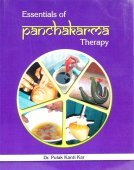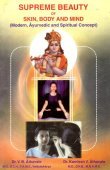Abhyanga, Abhyaṅga, Abhyamga: 19 definitions
Introduction:
Abhyanga means something in Hinduism, Sanskrit, the history of ancient India, Marathi. If you want to know the exact meaning, history, etymology or English translation of this term then check out the descriptions on this page. Add your comment or reference to a book if you want to contribute to this summary article.
In Hinduism
Ayurveda (science of life)
Source: archive.org: Vagbhata’s Ashtanga Hridaya Samhita (first 5 chapters)Abhyaṅga (अभ्यङ्ग) refers to “inunction”, and is mentioned in verse 2.7 and 4.20-22, 29-31 of the Aṣṭāṅgahṛdayasaṃhitā (Sūtrasthāna) by Vāgbhaṭa.—Accordingly, “[...] sesame-oil mixed with alkali and salt is recommended for inunction [viz., abhyaṅga]”.
Note (verse 2.7): Abhyaṅga (“inunction”) has been rendered by a hendiadys: bshu-byug, lit. “besmearing & anointing” (cf. 2.9 & 4.6). Expressing action-nouns this way is a favourite practice in Tibetan.
Source: PMC: Effect of Grīvā VastiAbhyaṅga (oleation)
Source: Easy Ayurveda: Carpal Tunnel Syndrome SymptomsAbhyanga: Massage with medicated oils always provides a soothing effect and relieves pain, numbness, tingling sensation etc symptoms. Care should be taken not to give a vigorous massage so as to aggravate the conditions. Abhyanga should be done under supervision of a qualified and experienced Ayurvedic doctor. Ayurvedic doctor might recommend oils or combination of oils and ghee (

Āyurveda (आयुर्वेद, ayurveda) is a branch of Indian science dealing with medicine, herbalism, taxology, anatomy, surgery, alchemy and related topics. Traditional practice of Āyurveda in ancient India dates back to at least the first millenium BC. Literature is commonly written in Sanskrit using various poetic metres.
General definition (in Hinduism)
Source: Wisdom Library: HinduismAbhyaṅga (massage) is a clinical feature used in Ayurveda.
Source: Aryacharya: Hinduismअभ्यङ्ग (Abhyaṅga) is the traditional Ayurveda massage. The purpose of अभ्यङ्ग (Abhyaṅga) is to apply herbal oil to the body and allow it to absorb into the body. The medicated oil is prepared and used according to the प्रकृति (Prakṛti) or विकृति (Vikṛti) of the person who is to receive अभ्यङ्ग (Abhyaṅga). There are variable techniques to apply the oil to the body and may be done as a one person or two person massage. The strokes applied vary and are occasionally designed to affect the वायु (Vāyu). Another procedure involved in अभ्यङ्ग (Abhyaṅga) is the administration of superficial friction massage, which helps with the absorption of the oil.
India history and geography
Source: Cologne Digital Sanskrit Dictionaries: Indian Epigraphical GlossaryAbhyaṅga.—(IA 22), smearing the body with oil. Note: abhyaṅga is defined in the “Indian epigraphical glossary” as it can be found on ancient inscriptions commonly written in Sanskrit, Prakrit or Dravidian languages.

The history of India traces the identification of countries, villages, towns and other regions of India, as well as mythology, zoology, royal dynasties, rulers, tribes, local festivities and traditions and regional languages. Ancient India enjoyed religious freedom and encourages the path of Dharma, a concept common to Buddhism, Hinduism, and Jainism.
Languages of India and abroad
Marathi-English dictionary
Source: DDSA: The Molesworth Marathi and English Dictionaryabhyaṅga (अभ्यंग).—m abhyañjana n (S) Rubbing the body with unctuous substances; inunction previous to ablution.
Source: DDSA: The Aryabhusan school dictionary, Marathi-Englishabhyaṅga (अभ्यंग).—m abhyañjana n Inunction previous to ablution, rubbing the body with unc- tuous substances.
Marathi is an Indo-European language having over 70 million native speakers people in (predominantly) Maharashtra India. Marathi, like many other Indo-Aryan languages, evolved from early forms of Prakrit, which itself is a subset of Sanskrit, one of the most ancient languages of the world.
Sanskrit dictionary
Source: DDSA: The practical Sanskrit-English dictionaryAbhyaṅga (अभ्यङ्ग).—
1) Smearing the body with unctuous or oily substances, smearing with oil; अभ्यङ्गने पथ्यमलंचकार (abhyaṅgane pathyamalaṃcakāra) Kumārasambhava 7.7; स्तन्यदानाभ्यङ्गपोषणादिभिः पुपोष (stanyadānābhyaṅgapoṣaṇādibhiḥ pupoṣa) Pañcatantra (Bombay) 5; Manusmṛti 2.178.
2) Smearing in general, inunction.
3) An unguent, salve, liniment.
4) cream of milk; (Nigh.).
Derivable forms: abhyaṅgaḥ (अभ्यङ्गः).
Source: Cologne Digital Sanskrit Dictionaries: Shabda-Sagara Sanskrit-English DictionaryAbhyaṅga (अभ्यङ्ग).—m.
(-ṅgaḥ) 1. Rubbing the body with unctuous substances; smearing the body with oil, inunction. 2. Unguent, liniment, oily application. 3. Applying collyrium to the eyes. 4. Sediment of oil, oil cake. E. abhi, and añja to anoint, ghañ aff.
Source: Cologne Digital Sanskrit Dictionaries: Benfey Sanskrit-English DictionaryAbhyaṅga (अभ्यङ्ग).—i. e. abi-añj + a, m. Unction, [Mānavadharmaśāstra] 2, 178.
Source: Cologne Digital Sanskrit Dictionaries: Cappeller Sanskrit-English DictionaryAbhyaṅga (अभ्यङ्ग).—[masculine] smearing, unction, unguent.
Source: Cologne Digital Sanskrit Dictionaries: Monier-Williams Sanskrit-English Dictionary1) Abhyaṅga (अभ्यङ्ग):—[=abhy-aṅga] [from abhy-añj] m. rubbing with unctuous substances, inunction, [Manu-smṛti ii, 178, etc.]
2) [v.s. ...] unguent, [Suśruta etc.]
Source: Cologne Digital Sanskrit Dictionaries: Goldstücker Sanskrit-English DictionaryAbhyaṅga (अभ्यङ्ग):—[tatpurusha compound] m.
(-ṅgaḥ) 1) Anointing, in general; e. g. Jaiminīyanyāyam.: jyotiṣṭome śrūyate dīkṣārthābhyaṅge…. tatra barhiṣi samūlacchedasyābhyaṅge navanītasya puroḍāśe yathocitapākasya ca vidheyatayā sarvamavaśiṣṭaṃ stāvakam. See also abhyañjana.
2) Rubbing the body with unctuous substances, smearing the body with oil, inunction; e. g. Suśr.: snānābhyaṅgadivāsvapnaśītavyāyāmayoṣitaḥ . na bhajeta svarotsṛṣṭo yāvanno balavānbhavet.—Raghunandana quotes in the Śuddhitattva (Ii. p. 132) the following definition (āyurvedoktapāribhāṣikaṃ) of the word: mūrdhni dattaṃ yadā tailaṃ bhavetsarvāṅgasaṃgatam . srotobhistarpayedbāhū abhyaṅgaḥ sa udāhṛtaḥ . tailamalpaṃ yadaṅgeṣu na ca syādvāhutarpaṇam . sā mārṣṭiḥ pṛthagabhyaṅgo mastakādau prakīrtitaḥ ‘when oil is applied to the head, goes over the whole body and delights with its flood the arms, this is called Abhyanga; but when little oil comes on the body and the arms are not much wetted, such partial inunction of the head &c. is called Mārṣṭi’. The medicinal effect of this practice is thus briefly described in the Rājanigh.: abhyaṅgo mārdavakaraḥ kaphavātavināśanaḥ . dhātūnāṃ puṣṭijananaḥ sutvamvarṇavalapradaḥ . pādābhyaṅgotha nidrākṛccakṣuṣaḥ pādarogahā . cakṣuṣi pratibaddhe dve śire pādagate nṛṇām . ataścakṣuḥprasādārthaṃ pādābhyaṅgaṃ samācaret (comp. also Wise, Hindu syst. of Med. p. 93). A religious student, an anchorete and a widow are forbidden to anoint themselves; Manu: (brahmacārī varjayet) abhyaṅgamañjanaṃ cākṣṇorupānacchatradhāraṇam); Prachetas (as quoted by Raghunand.): tāmbūlābhyañjanaṃ caiva kāṃsyapātre ca bhojanam . yatiśca brahmacārī ca vidhavā ca vivarjayet).
3) Unguent, liniment; e. g. Suśr.: sphoṭajanmarujāsrāvatvakpākaḥ svedanaṃ jvaraḥ . daraṇaṃ cāpi māṃsānāmabhyaṅge viṣasaṃyute. [
4) Applying collyrium to the eyes.
5) Sediment of oil, oilcake (Wilson)]. See the following. E. añj with abhi, kṛt aff. ghañ.
Source: Cologne Digital Sanskrit Dictionaries: Yates Sanskrit-English DictionaryAbhyaṅga (अभ्यङ्ग):—[abhya+ṅga] (ṅgaḥ) 1. m. Rubbing the body with an unctuous substance.
Source: DDSA: Paia-sadda-mahannavo; a comprehensive Prakrit Hindi dictionary (S)Abhyaṅga (अभ्यङ्ग) in the Sanskrit language is related to the Prakrit word: Abbhaṃga.
[Sanskrit to German]
Sanskrit, also spelled संस्कृतम् (saṃskṛtam), is an ancient language of India commonly seen as the grandmother of the Indo-European language family (even English!). Closely allied with Prakrit and Pali, Sanskrit is more exhaustive in both grammar and terms and has the most extensive collection of literature in the world, greatly surpassing its sister-languages Greek and Latin.
Kannada-English dictionary
Source: Alar: Kannada-English corpusAbhyaṃga (ಅಭ್ಯಂಗ):—
1) [noun] massaging the body with oil, unguents, perfumes, etc. and bathing.
2) [noun] the oil, unguents so anointed.
Kannada is a Dravidian language (as opposed to the Indo-European language family) mainly spoken in the southwestern region of India.
See also (Relevant definitions)
Partial matches: Anga.
Starts with: Abhyamgana, Abhyamganamgey, Abhyangasnana, Abhyangati, Abhyangavarga, Abhyangayati.
Ends with: Kshatabhyanga, Nirabhyanga, Tailabhyanga.
Full-text: Abbhamga, Abhyamga, Tailabhyanga, Abhyamgana, Appiyankam, Nirabhyanga, Toto, Katutaila, Abhyangati, Abhyangayati, Abhyangeti, Cokhani, Ayus, Snana, Nepathya, Mardana, Abhyanjana, Jata.
Relevant text
Search found 12 books and stories containing Abhyanga, Abhy-anga, Abhy-aṅga, Abhyamga, Abhyaṃga, Abhyaṅga; (plurals include: Abhyangas, angas, aṅgas, Abhyamgas, Abhyaṃgas, Abhyaṅgas). You can also click to the full overview containing English textual excerpts. Below are direct links for the most relevant articles:
Cosmetics, Costumes and Ornaments in Ancient India (by Remadevi. O.)
2.1. Pharmaceutical use of Oil < [Chapter 1 - Cosmetics]
The Skanda Purana (by G. V. Tagare)
Chapter 51 - Glorification of Dānadharma < [Section 3 - Revā-khaṇḍa]
The Shiva Purana (by J. L. Shastri)
Chapter 11 - Mode of worshipping the phallic form of Śiva and making gifts < [Section 1 - Vidyeśvara-saṃhitā]
The Garuda Purana (by Manmatha Nath Dutt)
Chapter XXIII - Description of another form of Shiva worship < [Agastya Samhita]
Charaka Samhita and Sushruta Samhita (by Nayana Sharma)
Practice of Therapeutics < [Chapter 4]
Related products


